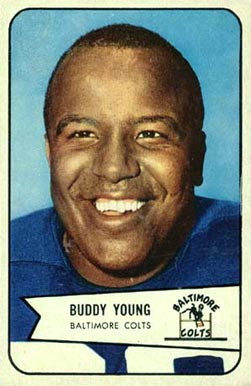Buddy Young facts for kids

Young with the Colts
|
|||||||||||||||||
| No. 76, 22 | |||||||||||||||||
|---|---|---|---|---|---|---|---|---|---|---|---|---|---|---|---|---|---|
| Position: | Halfback | ||||||||||||||||
| Personal information | |||||||||||||||||
| Born: | January 5, 1926 Chicago, Illinois |
||||||||||||||||
| Died: | September 1, 1983 (aged 57) Terrell, Texas |
||||||||||||||||
| Height: | 5 ft 4 in (1.63 m) | ||||||||||||||||
| Weight: | 175 lb (79 kg) | ||||||||||||||||
| Career information | |||||||||||||||||
| College: | Illinois | ||||||||||||||||
| Career history | |||||||||||||||||
|
|||||||||||||||||
| Career highlights and awards | |||||||||||||||||
|
|||||||||||||||||
| Career NFL statistics | |||||||||||||||||
|
|||||||||||||||||
| Player stats at PFR | |||||||||||||||||
|
College Football Hall of Fame
|
|||||||||||||||||
Claude Henry K. "Buddy" Young (born January 5, 1926 – died September 5, 1983) was an amazing American athlete. He was a star in both American football and track and field. Buddy was born in Chicago, Illinois. Even though he was only 5 feet 4 inches tall, he was incredibly fast. People called him the "Bronze Bullet" because of his speed. He was one of the shortest players ever in the National Football League (NFL).
Before playing pro football, Buddy was a track star at the University of Illinois. He won national championships in sprinting. He even tied world records for the 45 and 60-yard dashes. Buddy Young was truly a special talent.
Contents
Early Years: A Rising Star
Buddy Young was just as good at football as he was at track. Many colleges wanted him to play for them. He chose the University of Illinois. He became a star right away. In his very first game, he scored a touchdown on his first play. He ran 64 yards! Then, he scored another touchdown on his second try. He gained 139 yards in that first game.
By the end of his first season, he scored 10 touchdowns. This tied a record set by the famous player Red Grange. Everyone noticed Buddy's amazing skills. Sportscasters called him "The fastest thing in cleats." His coach, Ray Eliot, said Buddy was "The best running back I have ever seen." Even as a freshman, Buddy was named to several All-America teams.
Military Service and Wartime Football
During World War II, many athletes joined the military. Buddy Young joined the Navy in 1945. He played football for a service team called the Fleet City Bluejackets. These service teams were very strong. They had many top college and professional players.
Buddy played in a big championship game in Los Angeles. Over 65,000 fans watched. Buddy had one of his best games ever. He returned two kickoffs for touchdowns. One was 94 yards, and the other was 88 yards! He also ran for another touchdown. His team won the game 45–28.
People were amazed by Buddy's performance. Coaches and writers praised him. Comedian Bob Hope even said, "I'd heard of black magic...now I've seen it!" After his service, Buddy returned to the University of Illinois. He helped his team win the 1947 Rose Bowl. Illinois beat UCLA 45–14, and Buddy was named Co-Player of the Game.
World War II helped bring more fairness to sports. It gave Black athletes like Buddy a chance to show their talents. Buddy was one of the first Black players in professional football. He was often one of only a few Black players on his team. His friendly personality helped him become very popular.
Professional Football Career
Buddy Young played professional football for ten years. He started with the New York Yankees in 1947. Later, he joined the New York Yanks in the National Football League. The Yanks team eventually moved to Dallas and then became the Baltimore Colts. Buddy was one of the players who moved with the team to Baltimore. He retired from football after the 1955 season.
Buddy was a very versatile player. He could run, catch, and return kicks. Five times in his career, he gained over 1,000 all-purpose yards. In 1954, he was chosen for the Pro Bowl team. As a running back, he averaged 4.6 yards per carry. As a receiver, he averaged over 15 yards per catch. He was also great at returning kickoffs. In 1953, he averaged almost 28 yards per return. In one game against the Philadelphia Eagles, he returned the opening kickoff 104 yards for a touchdown! This was one of the longest kickoff returns in NFL history at the time.
Later Life and Honors
Buddy Young was a true pioneer. He was the first player for the Baltimore Colts to have his jersey number (No. 22) retired. This means no other player on the team can wear that number. In 1966, he became the first African-American executive hired by the NFL. He worked as the Director of Player Relations for the league.
Buddy Young passed away in 1983 at the age of 57. He left behind a great legacy in both sports and civil rights.

